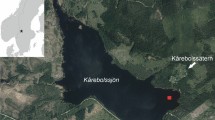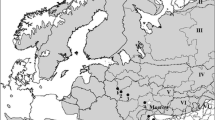Abstract
A peat profile from the village of Nellim in northern Finnish Lapland was analysed at a near-annual resolution in order to test to what degree of accuracy the land-use history of the village could be reconstructed on the basis of organic microfossils. The profile was first AMS 14C dated and a robust chronology constructed to enable near-annual sampling. A set of 47 contiguous samples were treated and counted to produce a pollen accumulation rate diagram (PAR, grains cm−2 year−1). PARs enabled a better distinction of the fine-scale human induced changes in the pollen assemblages than the classical percentage representation because real changes in each pollen taxon could be followed. Changes in the accumulation rate of pine pollen reflect regional changes in forest-use in Lapland and both local events and regional logging activity could be distinguished. Local within-mire changes were deduced from the peat stratigraphy and the testate amoebae. The limitations for using PARs seem to be connected to the physiology of the plants and the taphonomy of the different pollen types and this must be taken into account when making interpretations.






Similar content being viewed by others
References
Andersen ST (1970) The relative pollen productivity and pollen representation of North European trees, and correction factors for tree pollen spectra. Danmarks Geologiske Undersøgelse. II RÆKKE 96:99
Autere E, Liede J (1989) Petsamo nickel—a battle for metal (in Finnish with English summary). Vuorimiesyhdistys, Helsinki
Barnekow L, Loader NJ, Hicks S, Froyd CA, Goslar T (2007) Strong correlation between summer temperature and pollen accumulation rates for Pinus sylvestris, Picea abies and Betula spp. in a high-resolution record from northern Sweden. J Quat Sci 22:653–658
Berglund BE (1985) Early agriculture in Scandinavia: research problems related to pollen analytical studies. Norwegian Archaeol Rev 18:77–105
Berglund BE, Ralska-Jasiewiczowa M (1986) Pollen analysis and pollen diagrams. In: Berglund BE (ed) Handbook of Holocene palaeoecology and palaeohydrology. Wiley, Chichester, pp 455–484
Beug H-J (2004) Leitfaden der Pollenbestimmung für Mitteleuropa und angrenzende Gebiete. Pfeil, München
Borgmark A, Schoning K (2006) A comparative study of peat proxies from two eastern central Swedish bogs and their relation to meteorological data. J Quat Sci 21:109–114
Broström A, Nielsen B, Gaillard M-J, Hjelle K, Mazier F, Binney H, Bunting J, Fyfe R, Meltsov V, Poska A, Räsänen S, Soepboer W, von Stedingk H, Suutari H, Sugita S (2008) Pollen productivity estimates of key European plant taxa for quantitative reconstruction of past vegetation: a review. Veget Hist Archaeobot 17:461–478
Caseldine C, Fyfe R (2006) A modelling approach to locating and characterizing elm decline/landnam landscapes. Quat Sci Rev 25:632–644
Caseldine C, Fyfe R, Hjelle K (2008) Pollen modelling, palaeoecology and archaeology—virtualisation and/or visualisation of the past? Veget Hist Archaeobot 17:543–549
Charman DJ, Hendon D, Woodland WA (2000) The identification of testate amoebae (Protozoa: Rhizopoda) in peats. QRA Technical Guide No. 9, Quaternary Research Association, London
Davis MB, Deevey ES Jr (1964) Pollen accumulation rates: estimates from late-glacial sediment of Roger Lake. Science 145:1293–1295
Enbuske M (2003) Elämää laajan lapinkylän perintömailla (1650–1750). [Life in the wide Lapp heritage lands (1650–1750)]. In: Lehtola V-P (ed) Inari—Aanaar. Inarin historia jääkaudesta nykypäivään. [The history of Inari from the Ice Age to the present day.]. Inarin kunta, Oulu, pp 140–163
Fyfe R (2006) GIS and the application of a model of pollen deposition and dispersal: a new approach to testing landscape hypotheses using the POLLANDCAL models. J Arch Sci 33:483–493
Gaillard M-J, Berglund BE (1988) Land-use history during the last 2700 years in the area of Bjäresjö, Southern Sweden. In: Birks HH, Birks HJB, Kaland PE, Moe D (eds) The cultural landscape—past present and future. Cambridge University Press, Cambridge, pp 409–428
Gaillard M, Sugita S, Bunting MJ, Middleton R, Broström A, Caseldine C, Giesecke T, Hellman SEV, Hicks S, Hjelle K, Langdon C, Nielsen A-B, Poska A, von Stedingk H, Veski S, POLLANDCAL members (2008) The use of modelling and simulation approach in reconstructing past landscapes from fossil pollen data: a review and results from the POLLANDCAL network. Veget Hist Archaeobot 17:419–443
Giesecke T (2005) Moving front or population expansion: How did Picea abies (L.) Karst. become frequent in central Sweden? Quat Sci Rev 24:2495–2509
Goslar T, Van der Knaap WO, Hicks S, Andric M, Czernik J, Goslar E, Räsänen S, Hyötylä H (2005) Radiocarbon dating of modern peat profiles: pre- and post-bomb 14C variations in the construction of age–depth models. Radiocarbon 47:115–134
Goslar T, Van der Knaap P, Kamenik C, Van Leeuwen J (2009) Free-shape age-depth modelling of profiles dated with 14C—an ultrafine resolution chronology of the peat profile in Mauntschas. J Quat Sci (in press)
Grimm E (1990) TILIA version 2.0.b.4 and and TILIAGRAPH 2.0.4.b. INQUA Commission for the study of the Holocene. Sub-Commission on data-handling methods. Newsletter 4:5–7
Grönlund E, Kivinen L, Simola H (1992) Pollen analytical evidence for bronze-age cultivation in eastern Finland. Laborativ Arkeologi 6:37–42
Heiri O, Lotter AF, Lemcke G (2001) Loss on ignition as a method for estimating organic and carbonate content in sediments: reproducibility and comparability of results. J Paleolimnol 25:101–110
Hicks S (1993) Pollen evidence of localized impact on the vegetation of northernmost Finland by hunter-gatherers. Veget Hist Archaeobot 2:137–144
Hicks S (2001) The use of annual arboreal pollen deposition values for delimiting tree-lines in the landscape and exploring models of pollen dispersal. Rev Palaeobot Palynol 117:1–29
Hicks S (2006) When no pollen does not mean no trees. Veget Hist Archaeobot 15:253–261
Hicks S, Hyvärinen H (1999) Pollen influx values measured in different sedimentary environments and their palaeoecological implications. Grana 38:228–242
Itkonen TI (1991) Lapin matkani. [My journeys in Lapland] WSOY, Porvoo
Jalkanen R, Hicks S, Aalto T, Salminen H (2008) Past pollen production reconstructed from needle production in Pinus sylvestris at the northern timberline: a tool for evaluating palaeoclimate reconstructions. Silv Fenn 42:499–513
Kueppers LM, Southon J, Baer P, Harte J (2004) Dead wood biomass and turnover time, measured by radiocarbon, along a subalpine elevation gradient. Oecologia 141:641–651
Lehtola V-P (2003) Tuhon ja nousun vuodet (1939–1965). [The years of destruction and rise (1939–1939)]. In: Lehtola V-P (ed) Inari – Aanaar. Inarin historia jääkaudesta nykypäivään. [The history of Inari from the Ice Age to the present day.]. Inarin kunta, Oulu, pp 350–489
Luhta V (1999) Inarin havumetsävyöhyke, luonnonolot ja käyttö. [Natural conditions and use of the coniferous forest zone in Inari.] Metsähallituksen metsätalouden julkaisuja 21
Maher LJ Jr (1963) Pollen analyses of surface materials from the southern San Juan Mountains, Colorado. Geol Soc Am Bull 74:1485–1504
Maher LJ Jr (1981) Statistics for microfossil concentration measurements employing samples spiked with marker grains. Rev Palaeobot Palynol 32:153–191
Mielikäinen K, Nöjd P, Pesonen E, Timonen M (1998) Puun muisti. Kasvun vaihtelu päivästä vuosituhanteen. [Memory of a tree. Fluctuation of growth from a day to a millennium.] Metsäntutkimuslaitoksen tiedonantoja 703
Moore PD, Webb JA, Collinson ME (1991) Pollen analysis. Blackwell, Oxford
Mosimann JE (1965) Statistical methods for the pollen analyst. In: Kummel W, Raub D (eds) Handbook of paleontological techniques. Freeman and company, San Francisco, pp 636–673
Nahkiaisoja T, Lehtola V-P (2003) Ivalon nousun aika (1920–1939). [Upswing of Ivalo (1920–1939)]. In: Lehtola V-P (ed) Inari—Aanaar. Inarin historia jääkaudesta nykypäivään. [The history of Inari from the Ice Age to the present day.]. Inarin kunta, Oulu, pp 288–349
Nahkiaisoja T (2006) Lapinmaan maaoikeudet. Asutus ja maankäyttö Inarissa ja Utsjoella 1700-luvun puolivälistä vuoteen 1925. [Land right laws of Lapland. Settlement and land-use in Inari and Utsjoki from the mid 18th century until 1925.] Oikeusministeriön julkaisuja 2006:7
Odgaard B (1989) Cultural landscape development through 5500 years at Lake Skånsø, Northwestern Jutland as reflected in a regional pollen diagram. J Danish Archeol 8:200–210
Official statistics of Finland (1949–1964) Forest statistics 17 A. National Board of Forestry, Helsinki
Parshall T, Calcote R (2001) Effect of pollen from regional vegetation on stand-scale forest reconstruction. Holocene 11:81–87
Prentice IC (1985) Pollen representation, source area, and basin size: toward a unified theory of pollen analysis. Quat Res 23:76–86
Prentice IC, Parsons RW (1983) Maximum likelihood linear calibration of pollen spectra in terms of forest composition. Biometrics 39:1051–1057
Punt W et al (1976–2003) The Northwest European pollen flora, vol I(1976); vol II (1980); vol III (1981); vol IV (1984); vol V (1988); vol VI (1991); vol VII (1995); vol VIII (2003). Elsevier, Amsterdam
Räsänen S, Froyd C, Goslar T (2007) The impact of tourism and reindeer herding on forest vegetation at Saariselkä, Finnish Lapland: a pollen analytical study of a high-resolution peat profile. Holocene 17:447–456
Riipinen M (2005) Rural community of Nellim as a stage for land use discourses. In: Latola K, Siira T (eds) Human–environment encounter. Thule/NorNet Seminars Proceedings. Thule-Institute, Oulu, pp 31–37
Rose NL (1995) Carbonaceous particle record in lake sediments from the Arctic and other remote areas of the Northern Hemisphere. Sci Total Environ 160(161):487–496
Rose NL, Appleby PG (2005) Regional applications of lake sediment dating by spheroidal carbonaceous particle analysis I: United Kingdom. J Paleolimnol 34:349–361
Segerström U (1990) The natural Holocene vegetation development and the introduction of agriculture in northern Norrland, Sweden. Studies of soil peat and especially varved lake sediments. Umeå University, Umeå
Soepboer W, Vervoort JM, Sugita S, Lotter AF (2008) Evaluating Swiss pollen productivity estimates using a simulation approach. Veget Hist Archaeobot 17:497–506
Stockmarr J (1971) Tablets with spores used in absolute pollen analysis. Pollen et Spores 13:615–621
Stockmarr J (1972) Determination of spore concentration with an electronic particle counter. Danmarks Geologiske Undersøgelse Årbok, pp 87–89
Sugita S (1994) Pollen representation of vegetation in Quaternary sediments: theory and method in patchy vegetation. J Ecol 82:881–897
Suomen virallinen tilasto (1935) XIX Tie- ja vesirakennukset. Tie- ja vesirakennushallituksen kertomus sen johdonalaisista töistä vuonna 1933. [The official statistics of Finland XIX Road and water constructions. Road and water administration’s report 1933] Tilastokeskus, Helsinki
Suominen J (1975) On the plant cover at sites of ancient Lapp winter villages, Finnish Lapland. (in Finnish with English summary). Luonnon Tutkija 79:92–94
Tolonen K (1986) Rhizopod analysis. In: Berglund BE (ed) Handbook of Holocene palaeoecology and palaeohydrology. Wiley, Chichester, pp 645–666
Valtanen J (1994) Pohjois-Suomen suuret avohakkuut 1946–70. Yhteiskunnallinen tausta, toteutus ja vaikutukset. [The great clear cutting of northern Finland 1946–70. The social background, implementation and effects.] Metsäntutkimuslaitoksen tiedonantoja 533
Von Post L (1916) Skogsträdpollen i sydsvenska torvmosselagerfäljder. Det 16 Skandinaviske naturforskermøte 1916. 432–468 [Forest tree pollen in south Swedish peat bog deposits, translation by Davis MB and Faegri K (1967). Pollen et Spores 9:375–401]
Von Stedingk H, Fyfe RM, Allard A (2008) Pollen productivity estimates from the forest-tundra ecotone in mid-central Sweden: implications for vegetation reconstruction at the limits of the boreal forest. Holocene 18:323–332
Vorren K-D (1986) The impact of early agriculture on the vegetation of northern Norway—a discussion of anthropogenic indicators in biostratigraphical data. In: Behre K-E (ed) Anthropogenic indicators in pollen diagrams. Balkema, Rotterdam, pp 1–18
Vorren K-D, Nilssen E, Morkved B (1990) Age and agricultural history of the ‘-staðir’ farms of North and Central Norway. Norsk Geografisk Tidsskrift 44:79–102
Vuorela I (1970) The indication of farming in pollen diagrams from southern Finland. Acta Bot Fenn 87:1–40
Acknowledgments
The first author would like to thank her colleagues in the palaeoecology group at the Department of Geosciences for inspiring discussions and coffee breaks during the course of this study. Chris Caseldine is thanked for valuable comments on an earlier version of the manuscript. Antti Huusko is sincerely thanked for the assistance with all the mathematical problems. Kristiina Karjalainen assisted in drawing the maps in Fig. 1. Further thanks to Timme Donders and André F. Lotter who both provided valuable comments on an earlier version of this paper. The funding for this research was provided by the Academy of Finland (project NORDPINE 1205995). This article is also a contribution to EU-funded project Predicting Impacts on Natural Ecotones (PINE EVK2-CT-2002-00136).
Author information
Authors and Affiliations
Corresponding author
Additional information
Communicated by A.F. Lotter.
Rights and permissions
About this article
Cite this article
Kuoppamaa, M., Goslar, T. & Hicks, S. Pollen accumulation rates as a tool for detecting land-use changes in a sparsely settled boreal forest. Veget Hist Archaeobot 18, 205–217 (2009). https://doi.org/10.1007/s00334-008-0205-3
Received:
Accepted:
Published:
Issue Date:
DOI: https://doi.org/10.1007/s00334-008-0205-3




